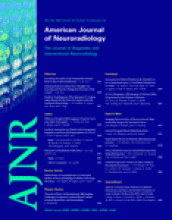EditorialEDITORIAL
Death by Nondiagnosis: Why Emergent CT Angiography Should Not Be Done for Patients with Subarachnoid Hemorrhage
David F. Kallmes, Kennith Layton, William F. Marx and Frank Tong
American Journal of Neuroradiology November 2007, 28 (10) 1837-1838; DOI: https://doi.org/10.3174/ajnr.A0809
David F. Kallmes
Kennith Layton
William F. Marx

References
- ↵Karamessini MT, Kagadis GC, Petsas T, et al. CT angiography with three-dimensional techniques for the early diagnosis of intracranial aneurysms: comparison with intra-arterial DSA and the surgical findings. Eur J Radiol 2004;49:212–23
- ↵Hoh BL, Cheung AC, Rabinov JD, et al. Results of a prospective protocol of computed tomographic angiography in place of catheter angiography as the only diagnostic and pretreatment planning study for cerebral aneurysms by a combined neurovascular team. Neurosurgery 2004;54:1329–40
- ↵
- ↵Rosenom J, Eskesen V, Schmidt K, et al. The risk of rebleeding from ruptured intracranial aneurysms. J Neurosurg 1987;67:329–32
- ↵
- ↵Wang LC, Colen T, Cohen W, et al. Evaluation of nontraumatic subarachnoid hemorrhage: CT angiography versus digital subtraction angiography. Presented at: 44th annual meeting of the American Society of Neuroradiology, San Diego, Calif, May 1–5,2006
- ↵Lane BF, Zoarski GH, Husain MA, et al. Sensitivity of multidetector CT angiography for the detection of intracranial aneurysms. Presented at: 44th annual meeting of the American Society of Neuroradiology, San Diego, Calif, May 1–5,2006
- ↵Hankey GJ, Warlow CP, Sellar RJ. Cerebral angiographic risk in mild cerebrovascular disease. Stroke 1990;21:209–22
In this issue
Advertisement
David F. Kallmes, Kennith Layton, William F. Marx, Frank Tong
Death by Nondiagnosis: Why Emergent CT Angiography Should Not Be Done for Patients with Subarachnoid Hemorrhage
American Journal of Neuroradiology Nov 2007, 28 (10) 1837-1838; DOI: 10.3174/ajnr.A0809
0 Responses
Jump to section
Related Articles
- No related articles found.
Cited By...
- Use of the 2.8 French Progreat microcatheter in diagnostic cerebral angiography
- Evaluation of cerebral arteriovenous malformation using 'dual vessel fusion' technology
- Diagnostic yield of delayed neurovascular imaging in patients with subarachnoid hemorrhage, negative initial CT and catheter angiograms, and a negative 7 day repeat catheter angiogram
- Use of CT Angiography and Digital Subtraction Angiography in Patients with Ruptured Cerebral Aneurysm: Evaluation of a Large Multihospital Data Base
- Should American Journal of Neuroradiology Commentary Be Evidence-Based?
- Diagnostic Yield of Catheter Angiography in Patients with Subarachnoid Hemorrhage and Negative Initial Noninvasive Neurovascular Examinations
- Cerebral Angiography: Not Yet Ready to Join the Dinosaurs
- Reply:
- Reporting standards for endovascular repair of saccular intracranial cerebral aneurysms
- Reporting Standards for Endovascular Repair of Saccular Intracranial Cerebral Aneurysms
- Multi-Detector Row CT Angiography with Direct Intra-Arterial Contrast Injection for the Evaluation of Neurovascular Disease: Technique, Applications, and Initial Experience
- Reporting Standards for Endovascular Repair of Saccular Intracranial Cerebral Aneurysms
- Coil Embolization of Very Small (2 mm or Smaller) Berry Aneurysms: Feasibility and Technical Issues
This article has not yet been cited by articles in journals that are participating in Crossref Cited-by Linking.
More in this TOC Section
Similar Articles
Advertisement











